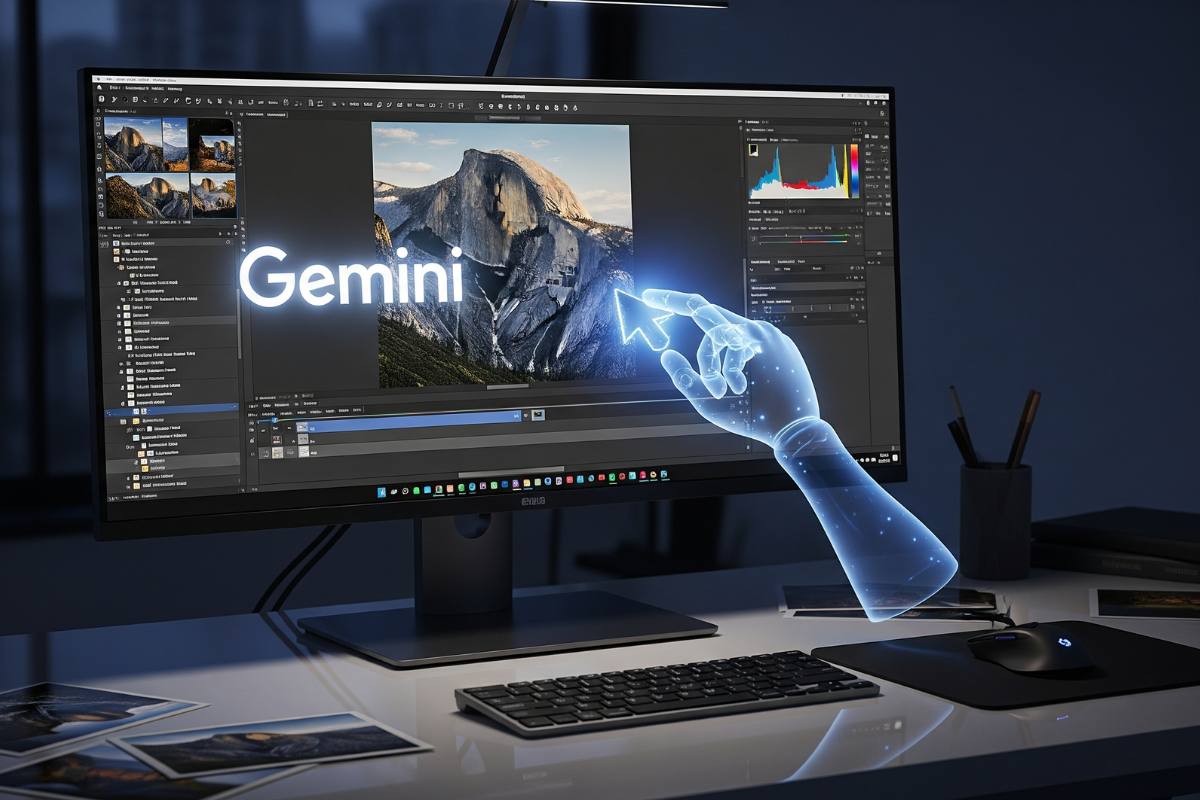Google’s new AI image model, nicknamed “Bananas” and officially called Gemini 2.5 Flash Image, is rolling out inside the Gemini app with precise, natural-language photo edits, consistent character likeness, and multi-step control. Here’s how to use it right now without extra software.
The quick take
Google confirmed that the viral “nano-banana” editor is its own model, now integrated into Gemini, bringing fast, fine-grained photo editing to both free and paid users on web and mobile, with visible and invisible AI watermarks enabled by default. The model, formally Gemini 2.5 Flash Image, focuses on maintaining a subject’s look across edits, blending multiple photos, and making targeted, local changes via simple prompts rather than complex layer-based workflows. In practice, that means fewer weird artifacts, better consistency across versions, and edits that tend to stick where they’re supposed to, room paint stays on walls, masks don’t drift, faces don’t morph.
What ‘Bananas’ actually is
Under the playful moniker “nano-banana,” Google’s latest image engine is the image generation and editing component of the broader Gemini 2.5 Flash family, optimized for responsiveness and creative control inside the Gemini app and via the Gemini API. Google says the update adds major capabilities: character consistency across images, multi-image fusion, and precise, prompt-driven local edits that latch onto the right region without undoing the rest of the scene. The same system works for both creating images from scratch and editing existing photos, allowing users to keep a person, pet, or product looking like itself while testing costumes, locations, and styles.
Why it matters
Image generation has surged, but editing, especially of real people, has remained the hard part, where models often break faces, warp hands, or “forget” the background context during multi-step changes. Google claims its new model reduces those failures and has topped or challenged editing leaderboards like LMArena, an area where consistency and local control matter more than one-shot photorealism. The goal is straightforward: make high-quality edits accessible in seconds, no heavyweight desktop software needed, and do it reliably enough that people trust the results for personal photos and brand assets alike.
How to edit photos with Gemini
- Open the Gemini app on Android or iOS, or use Gemini on the web, where the new editor is already integrated into the default Gemini 2.5 Flash experience for supported regions.
- Upload a photo and type a natural-language prompt describing the change, “replace the background with a sunlit library,” “make the T‑shirt red,” “add subtle bokeh to the background,” and wait a few seconds for the result.
- For finer control, keep the conversation going with multi-turn edits: confirm what worked, then ask for small adjustments, light, color, pose, or object removal, without starting over.
- To combine photos, upload multiple images and ask Gemini to blend them, put a person and a pet together on the same court, or apply the pattern from one image to the product in another.
- On mobile, the workflow is similar: select the Gemini 2.5 Flash model, add an image via the plus icon, enter a specific prompt, and save the high-resolution output if satisfied.
Feature deep dive
- Character consistency: The model keeps a person’s face and look stable across edits and scenarios, matador outfit, 90s sitcom scene, and different lighting, so the subject stays recognizably the same.
- Targeted, local edits: Ask for precise changes, remove a stain, blur background, recolor a shirt, adjust a pose, without derailing the rest of the image, using simple instructions instead of selections or masks.
- Multi-image fusion: Merge objects, people, and styles across photos in one prompt, place a specific product in a new setting or restyle a room using a color palette from another image.
- Design mixing: Transfer style, color, and texture from one image to another, like mapping pink roses onto rain boots for a floral pattern that’s cohesive and photorealistic.
- Multi-turn editing: Iterate in steps, paint the walls, add furniture, refine lighting, while the system preserves the rest of the scene between each change.
Availability and daily caps
Google says the editor is now available to both free and paid Gemini users on the web and mobile, and in preview via the Gemini API, Google AI Studio, and Vertex AI for developers and enterprises. For now, daily limits apply: free accounts can make up to 100 image edits per day, while paid accounts can perform ten times as many edits. Adobe Express and Firefly users can also access the upgraded model as it rolls out, broadening reach beyond the Gemini app.
Watermarks, safety, and privacy
All images created or edited in the Gemini app include a visible label plus an invisible SynthID digital watermark, so AI content can be identified downstream. Google reiterates that SynthID is applied to the new model’s outputs, aligning with the company’s approach to provenance and platform trust. Gemini’s privacy documentation cautions against uploading sensitive personal content, and its policies prohibit illegal or abusive use cases, guidelines that continue to apply to the new editor.
The viral backstory
Before today’s confirmation, “nano-banana” appeared as an anonymous entrant on LMArena and quickly climbed the image-editing charts, sparking speculation that it might be Google’s. The company has now taken ownership of the model and its performance, and it’s integrating the engine into Gemini so it’s not just a leaderboard curiosity but an everyday tool. That shift, from a mysterious testbed identity to a named model inside a mainstream product, signals that Google views refined editing, not just flashy generation, as the next adoption driver.
Real-world examples
In demonstrations, Google shows a reference photo of a person transformed into a matador, with likeness maintained across variants, a common failure mode for older models that now appears more controlled. Another example steps through visualizing a room refresh: repainting walls, adding furniture, and tweaking the scene, all in successive prompts without losing the layout. There’s also a design-mixing sample where a pattern from one image is used to restyle boots in another photo, illustrating both local control and style transfer in a single flow.
Quick start prompts
- “Change the background to a coastal boardwalk at golden hour; keep the subject’s face unchanged.”
- “Blend these two images so the person is hugging the dog on a basketball court; keep proportions realistic.”
- “Apply the pink rose pattern to these rain boots; maintain the original boot shape and lighting.”
- “Remove the coffee stain on the shirt and slightly blur the background to simulate shallow depth of field.”
- “Recolor the T‑shirt to deep red while preserving the stripe pattern and fabric texture.”
Tips for cleaner edits
- Keep prompts specific, but short, mention the subject, the target region, and the desired change; clarity helps the model localize edits without unintended side effects.
- Iterate rather than overpack a single prompt; multi-turn editing typically yields more predictable results on complex scenes.
- Respect daily limits by batching edits; free tiers allow up to 100 image edits per day, with paid tiers offering roughly ten times that headroom for heavier use.
- Save intermediate versions so it’s easy to roll back, especially when blending multiple photos or testing bold style transfers.
Competitive context
Independent tests and early user feedback suggest Gemini 2.5 Flash Image performs especially well on small, surgical tweaks, where rivals sometimes smear textures or shift identity when faces are involved. Publications tracking LMArena have noted the model’s strong editing performance, with Google and observers framing consistency as the differentiator rather than one-off photorealism. Tech press coverage has also placed the move in a broader pattern: Google is pushing Gemini to better compete with ChatGPT and other AI editors, folding viral tools directly into its consumer apps.
Free vs paid vs developer access
| Tier | Where it’s available | Daily edit limit | Watermarking | Notes |
| Free Gemini users | Gemini app (web/mobile) | Up to 100 edits/day | Visible label + SynthID | Model integrated into Gemini 2.5 Flash experience |
| Paid Gemini users | Gemini app (web/mobile) | Up to 1,000 edits/day | Visible label + SynthID | Higher cap for heavier creative workflows |
| Developers (API/Studio/Vertex) | Gemini API, Google AI Studio (preview), Vertex AI | Metered pricing | SynthID in outputs | Pricing roughly $0.039 per image, via tokens |
For developers: build with the new model
Gemini 2.5 Flash Image is immediately available in preview through the Gemini API and Google AI Studio, and on Vertex AI for enterprise, with per-image costs derived from output tokens. Google has published template apps in AI Studio for character consistency, local edits, design templates, and multi-image fusion, which can be remixed with minimal configuration. The company is also distributing access via partners like OpenRouter and fal.ai. Fal is already exposing “nano-banana” endpoints for commercial image editing workloads.
Policy and provenance
All Gemini-edited images in the app carry a visible “AI-generated” label in addition to the invisible SynthID watermark, a dual approach meant to increase transparency across platforms. The watermarking is consistent with earlier Gemini content labeling and applies as well to the 2.5 Flash Image pipeline accessible to developers. Google also flags the standard AI policy expectations, avoiding sensitive personal data uploads and respecting prohibited use rules, advising caution for images that might include private or regulated information.
Background and timeline
Google launched native image generation in Gemini 2.0 Flash earlier this year, emphasizing speed and low latency, then heard feedback requesting greater quality and control, hence the 2.5 Flash Image upgrade. The company has been systematically layering generative media capabilities across its products, from image and video tools announced around I/O to consumer-facing experiments like NotebookLM, as part of an ongoing push to broaden creative workflows. With the “nano-banana” editor now public and integrated, Google says it will keep improving long-form text rendering, character consistency, and fine-grained factual details in images.
Step-by-step: Gemini app and web
- Launch Gemini and confirm the default model is Gemini 2.5 Flash, where image editing is now natively available for supported users and regions.
- Add a photo to edit; if the goal is generation, start from a text prompt and let the model compose an image, then iterate.
- Enter clear instructions that isolate the target: “replace the sky with a moody overcast,” “subtle skin tone balance,” or “remove the person in the background near the left lamp.”
- Use multi-turn edits to refine: adjust saturation, roll back a change, or try an alternate style without losing the subject’s identity.
- Download or share the result; images will contain visible and invisible watermarks indicating AI assistance.
What experts and testers are seeing
Business Insider’s internal tests reported the model handled small, surgical tweaks well, like recoloring a shirt while preserving a stripe pattern, where alternatives sometimes blurred textures or altered identity. Ars Technica and 9to5Google noted the model’s leaderboard strength for editing tasks and emphasized the practical advantage of character consistency as edits pile up. TechCrunch framed the rollout as a catch-up move against rivals, but one that leans into Gemini’s speed and control, rather than yet another maximal photoreal generator.
When to reach for it
- Quick social-ready edits: color fixes, background cleanup, and subtle portrait tweaks, all without exporting to desktop tools.
- Consistent series: campaign images where the same person, pet, or product must look identical across varied backdrops or outfits.
- Creative blends: multi-image composites that require a product to pop in a new environment or a style to travel from one asset to another.
- Iterative staging: visualizing room or set changes step by step, preserving layout while exploring decor, paint, or furniture ideas.
Limits and expectations
Even with better local control, complex composites can occasionally misinterpret intent, especially when instructions are vague or reference occluded details, so iterating helps. Early crowd tests placed the nano-banana preview among top contenders but not always first for raw image generation; the editor’s sweet spot is controlled, multi-step adjustment rather than single-prompt spectacle. Google notes that it’s still improving long-form rendering and fine detail in images, which can surface in edge cases like tiny logos or intricate text.
The bottom line
The “Bananas” model, Gemini 2.5 Flash Image, turns Gemini into a practical, fast photo editor that favors precision, identity preservation, and promptable control, and it’s now broadly available with sensible guardrails and generous free-tier limits. For quick, consistent edits and creative blends, it’s designed to replace basic manual workflows, and, in many cases, the need to even open a heavyweight editor in the first place.

































This is very useful